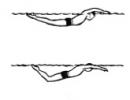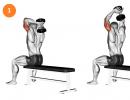How to drain the frame pool completely. Draining the water from the pool: just about the important. When the water is drained from the pool
Sooner or later, any type of artificial reservoir will require water to be drained.
Water drains:
at the end of the bathing season with severe turbidity and contamination, if its filtration is not possible when substances hazardous to humans enter the water for troubleshooting and repairing coatings when the bowl overflows with rainwater
How to drain water from a stationary pool
Stationary (buried) according to the rules must have a circulation and drainage system, which is laid at the initial stages of construction. It includes suction nozzles, drains or bottom nozzles. The water will drain on its own through the open drain hole. Also, there is usually a multi-mode valve on the filters that starts the discharge of water into the sewer. It is enough to select the valve mode (flushing / draining) and ensure that the hose (pipe) exits to the place where the liquid is drained (for example, a pit). After that, we start with the pump and monitor the removal of liquid. When doing this, keep in mind that the water will be lowered to the level of the last suction nozzle in this way. The rest of the liquid is drained into the bottom hole or pumped out.
How to drain water from a Bestway pool
You can empty it in the same way with other models similar in design (see above):
- there is a drain valve - open the plug and connect the hose;
- partial descent of water - select the flush / drain mode on the tap of the filter tank and start the filtration;
- drain is not provided, there is no filter with tap position “Drain” – pump out the water with an external pump.
Where to drain water from the pool in the country
A swimming pool is a desirable accessory in the summer season in any area. In order for the operation of the pool to always be comfortable, it is necessary to take care of it - change the water and clean it.
It is ideal to drain water into the sewer system, if any. You will not worry about the swampy area. However, suburban areas rarely have centralized sewerage, so draining large volumes of water can be a problem for users. Large volumes of water are usually treated with products based on chlorine, oxygen or bromine. The use of chemical water has a number of nuances and determines the method of disposal / processing of such a liquid.
Water is treated with chemicals:
- In country houses, it is recommended to drain into a cesspool. But keep in mind that it may not be suitable for draining large pools, because. this may cause it to overflow.
- In this case, equip a separate water intake for draining. The reservoir for water diversion is designed taking into account the volume of the pool (as a rule, the size of the water intake is calculated with a margin). This will allow you to drain the pool if necessary.
not used:
- Organize a drain into natural reservoirs or arrange special ditches to distribute water throughout the site.
- Pools can be an excellent source of water for watering plants and irrigation systems. This is especially true for arid zones and areas with a problematic water supply regime.
- ! The volume of the pool bowl must be less than the volume of the drain pit or receiver into which the water is drained.
- ! When connected to the sewer, the pipes must be sloped so that the water leaves and does not return. The drain pipe must be equipped with a valve.
- ! Please note that the size of the pipe or hose (diameter) determines the rate of drainage.
- ! If the water in the pool is treated with chemicals, then it cannot be used for irrigation, draining into ponds or other natural water bodies.
- ! Drainage into water bodies is possible only if it does not contradict the environmental legislation adopted in the given region.
Even in the process of planning an artificial reservoir, you need to think about how and where the water will be drained from the pool. The water drainage system is one of the primary tasks that is quite realistic to solve on your own. You just need to know how to properly drain the water from the pool, where it is better to do it and what is needed for this.
Where to drain water from a pool or pond: available options
The organization of the disposal of used water from a pond or pool is a very important task. This can be a real problem if there is no natural reservoirs where the water could be drained. In the case of the closest location near a lake or river, you are unlikely to have questions related to where to drain the used water from an ornamental pond or pool, since such water will not harm the environment. Also, for these purposes, a natural ravine is suitable, along which flood and rain water flows. However, how to drain water from a pond or pool if such benefits of nature are absent?
First of all, remember that draining the water from the pond or pool should not be done daily or monthly.

In there is water exchange: liquid from the bottom or from the surface is taken by a special pump, filtered, heated if necessary and returned back to the pond or pool tank. Such a system frees owners from the constant draining of large volumes of liquid. However, despite this, sometimes it becomes necessary to intentionally drain all the water from the tank.
Water from a pond or pool can also be drained to the site, because it does not have harmful impurities, but this procedure should also be carried out carefully. Since the volumes of liquid are very large, uncontrolled discharge of water into the ground can lead to waterlogging of the soil. Sewerage remains, however, there are some peculiarities here. Water in such volumes can only be received by a centralized sewage system, and in summer cottages it is usually autonomous, and the septic tank is probably not designed for such a volume. It will simply choke, and it will be necessary to immediately pump out the liquid.
It may happen that the microorganisms that are involved in the processing of waste products are washed away, as a result of which the autonomous sewage system will lose its main function. Therefore, the owners of suburban artificial reservoirs, who, after bathing their many guests, decide to drain the water from the pond or pool into an autonomous sewer, will be forced to pay money to sewers for pumping water from overflowing tanks.
Back to index
How to drain water from a large pool?

Constructive solutions for draining and water overflow systems: a - dug-in pool; b - semi-dug pool; 1 - drain pipe; 2 - overflow; 3 - drain valve handle; 4 - connection of the overflow pipe with the drain pipe; 5 - protective nets; 6 - outlet from overflow without forced pumping out; 7 - to the pumping pump.
If it becomes necessary to drain water from a large pond, pool or other artificial reservoir, then this procedure must be approached very seriously: in order to protect the reservoir from stagnation of dirty water, and the territory from swamping, it is necessary to provide an autonomous drain. drain water from the pond. But then the drain should not be massive and emergency, when the entire volume of water is sent to the septic tank, but measured so that the system can cope with such an amount.
Don't forget one more thing important factor: the pond must be connected to the sewer through some kind of jet interruption device. To do this, it is necessary to make a well or pit so that bacteria and sewage from the sewer system do not penetrate into the pond bowl. To avoid overloading the system, water must be drained into the last stage of the septic tank.
To drain the liquid into the ground, technical schemes are needed that will allow the water to go into the ground, and not form a swamp. To do this, you can use the filtration fields, which are usually used if a local sewage system is installed on the site. If there is a storm sewer, water from the pond can be drained into it. In addition to all of the above, some have drainage wells on their land plots. With normal volumes of water, the drain can be performed in the drainage system.
Many summer residents and gardeners may have a completely understandable question: why uselessly transfer normal water in a hot summer? In any case, the crop on the site needs to be constantly watered, so why not use water from the pool for this? Experts do not advise using such water if some chemicals were used during the operation of the reservoir, albeit in small quantities.
Back to index
When to drain the water from the pool or pond?
It is also necessary to decide on the frequency of draining water from a pond or pool. Such an operation should be carried out at least after the end of the swimming season. However, many professionals do not quite agree with this point of view. They believe that draining the liquid on winter time do not need to be done, as this procedure may adversely affect the design of the pool. As you know from the school physics course, frozen water increases in volume. Following this rule, you can come to the following conclusion: the water contained in the ground, freezing and becoming ice, will put pressure on the bowl, and from this even the most durable concrete can easily crack, as a result of which all your work will turn out to be just a waste of time. and strength. Relying on the experience of operating open artificial reservoirs in harsh Russian climatic conditions, it is not always correct to drain water from the pond in the winter, because. soil movements can cause deformation of the pool bowl.

Installation of a shutter for a drain device: 1 - pipe neck; 2 - the bottom of the pool; 3 - grid; 4 - ball; 5 - wire ear; 6 - tripod; 7 - cable.
There are several different points of view on this issue. Some experts recommend completely draining the water, cleaning the tank, plugging the pipes, and then half filling the tank with water. Others are of the opinion that the tank must be left 50% full so that the frozen liquid compensates for the pressure of the bowl with freezing soil. Another opinion says that water can not be drained for several years if you constantly clean the container and monitor its sanitary condition. In their opinion, water can not be changed for about 3 years, if the equipment for water purification and disinfection is properly selected. Modern systems water treatment systems are able to automatically maintain a certain level of purity and the required temperature.
A lot of problems can be brought by poorly arranged waterproofing of the reservoir bowl. Due to the fact that the container has a large volume, which means that the volume of liquid will also not be small, the water begins to exert pressure on the walls in order to find at least some gap where it could leak. High-quality waterproofing will be able to cope with this pressure, and if it is not done in good faith, then water will pass into the soil, which will result in waterlogging of the site. In addition, poor-quality waterproofing can lead to other unpleasant consequences in the form of undermining the foundation of a house and other outbuildings. The purity of the water in the pond depends on the quality of the waterproofing. The penetration of groundwater also leads to pollution of the reservoir, so you will immediately lose any desire to splash in such a pond. For the drain device, you will need the following tools and materials:
- tiler's trowel;
- shovel;
- sand;
- brick;
- asbestos plate 5-10 mm or metal 2-3 mm;
- cement brand 500.
30.07.2009, 10:24
Volodya Volodya
30.07.2009, 11:16
Help with advice - I bought a large inflatable pool, I thought that I could drain the water either with an ordinary hose or a deep electric. well pump and miscalculated. Through a hose connected to the drain hole of the pool (the hose is long, 7 meters), the water does not want to leave at all (I don’t know what’s the matter, maybe there is not enough water pressure), and the deep pump turned out to be stationary and cannot be transferred to the pool. How to drain water from the pool with improvised means? Do not offer buckets, I don’t drag so much water to the ditch in a week :)) It’s difficult to buy a pump now, the purchase has ended, I haven’t seen such pumps without a pool in stores.
Can I buy a wider hose?:009:
Have you ever seen how they drain gasoline?
If not, here's a short guide for you :)
Take the hose, lower one end into the pool, throw the other on the ground, preferably below the pool, but before you throw it on the ground, draw water into the hose with your mouth (like from a glass of lemonade), and then throw :)
30.07.2009, 19:15
30.07.2009, 19:22
We drain the pool as Volodya Volodya suggested, during the night all the water leaves
what's the fun????
30.07.2009, 19:47
And if you drain the old driver's way, I recommend not to suck in air with your mouth (you need to suck in a lot), but fill the hose with water through a funnel.
Or just gradually lower the hose with one end into the pool, allowing air to escape from the other end. When the hose is all in water, plug one end of it with your finger (the second should be under water all the time), pull it out and drag it to the drain point. There, lower the hose to the ground and open the hole. The water will flow by itself.
01.08.2009, 10:28
Take the hose, lower one end into the pool, throw the other on the ground, preferably below the pool, but before you throw it on the ground, draw water into the hose with your mouth (like from a glass of lemonade), and then throw :)
Deal with the drain hole of the pool. Maybe it is closed from the inside with a cork? If you just open the drain hole, does water come out?
01.08.2009, 10:51
Thanks for the advice! :flower: They told me that there could really be problems in the pressure in the hose (there are holes and therefore the water is not "drawn in").
I can’t lower the hose into the pool, because. the pool is located 50 meters from the ditch and there will be no sense in letting go due to the large length of the hose. The drain hole works great, if you open it - the water gushes :)), but when you connect the hose (I made a mistake here with the indication of the footage, there are 15 meters and I attach another 30 m :))), the water does not flow. I bought a new large-diameter 15 m hose today, I'll try to insert it tightly and see what happens. If the water comes out, then I will attach it to another hose and try to drain it. At least, if it works in the new one, then I will know that the reason for the previous failures is in the micro-punctures of the old hose. Well, if not, I'll come back here for further reflection: 009:
When the hose is connected to the drain hole, tightness and micro-holes in the hose do not matter, because. V this case The hose does not work for suction, but for forcing. Through micro-punctures, water would simply ooze out of the hose, but the main part of the water would reach the end.
Perhaps the problem is elsewhere. At such a large distance - 50 m - the far end of the hose may be above the water level in the pool (or somewhere in the middle, on some bump, it rises above the water level). In this case, of course, the water will not flow by itself ...
The tightness of the hose would matter if it was thrown over the edge of the pool, or if the water was pumped out using an external pump.
02.08.2009, 20:06
06.08.2009, 01:00
And why not buy an ordinary inexpensive submersible pump - it costs about the same as the hose you bought? About 1000 rubles. We attached a hose to it, a pump to the pool, an extension cord to the outlet. I personally merge like this) Or are there problems with electricity?
No, there are no electrical problems. But I didn’t see submersible pumps in the store, I ran through several, I saw 3000-5000 each, I didn’t raise my hand for 1 time to buy :)).
Problem solved! I connected a new hose, sealed everything hermetically, fumbled for an hour, but the water still did not go. Then, out of anger, she pulled the hose hard and oh! joy! water flowed: 080: What and why - I don’t know, don’t ask, but in a state of rigid stretching of the hose, the water slowly merged into the ditch. True, the pleasantness was not without a fly in the ointment ... in parallel with the drain, she turned on the pump to draw water into the bucket, and then forgot about it. I remembered only at three in the morning: 001:. By the effect of forgetfulness - I could just open the lid of the pool and drain the water to the ground, I think there would be less water :))
06.08.2009, 11:12
Problem solved! I connected a new hose, sealed everything hermetically, fumbled for an hour, but the water still did not go. Then, out of anger, she pulled the hose hard and oh! joy! water flowed: 080: What and why - I don’t know, don’t ask, but in a state of rigid stretching of the hose, the water slowly merged into the ditch.
So, these were the so-called "air jams". When the hose is not level on the ground, i.e. some sections of the hose are higher than others, there is not enough water pressure to force air bubbles through the hose.
By straightening the hose, you allowed the bubbles to come out of the hose and the water flowed out.
One of the most important activities related to the pool is the organization of the runoff. Learn how to properly drain a pool.
Draining the water from the pool is one of the most important processes in its use, so it must be thought out in advance. High-quality work of the drain will be ensured only if it fully complies with the type of structure, its location, as well as sanitary and technical standards.
We equip the drain of water from the pool
It is possible to arrange several types of waste water drainage from the pool, each of which directly depends on many factors. Here, it is required to take into account the contamination of the liquid, its volume, the frequency of draining, the distance to the place of water intake.
Standard water drain
by the most in a simple way drain water from the pool is the drain supply to the sewer. It is possible to organize and equip everything not only with stationary structures inside the house or capital, detached buildings, but also with small inflatable and frame models.
To do this, you will only need to install a drain in the pool itself, make a connection to the sewer, run the pipes and lay them in the right direction and with a certain slope. The liquid will leave faster if the diameter of the labor is correctly selected and the distance to the sewer will be minimal.
Management of pool filtration modes (VIDEO)
Drainage to the garden and beds
Using small pools, for example, frame or generally inflatable for children, draining often occurs simply in the garden or in the garden of the land. The task is simplified if the structure is located on a slight slope or near drainage pits and ditches.
Thus, you can simply open the relief valve or lead the hose from it into required space, and soon the waste water from the tank will go away by gravity, and you can replace it with clean water.
Also for this process, you can also use a medium power pump, which will help convert the water from the pool into an excellent pressure for watering flower beds and beds.
Draining water into a septic tank
Experts do not recommend draining fluid from the pool into septic tanks and cesspools, since literally in one discharge you can completely fill the volume. Another thing is if the drain is organized into a special pit for draining wastewater, which will be dug to a depth below the level of the tank, and preferably to the sand and gravel soil layer.
In this case, the contents of the structure will leave much faster, and if you use the pit strictly for its intended purpose, it will be able to help you with a quality drain.
Drainage from the pool to the reservoirs
From the side of organizing such a drain, everything is very simple and even inexpensive, but from the side of the legality and ethical standards of a civilized person, it is, of course, worth thinking about. Naturally, it is possible to equip the drainage of waste water into a river or lake, but only if the liquid does not contain a large number chemistry.
Cleansing activities
In this case, it would be nice to use special filters for pools, which will be responsible for the purity of waste water, or special settling wells. We also recommend that you communicate with the services of your region that oversee such issues in order not to run into large fines for environmental pollution.
Stock system automation
Automated drainage of water from the structure is possible in any of the above cases, and it is even recommended to increase the rate of emptying the structure and the ability to reuse the liquid (if it does not contain a lot of chemicals).
For this, you should consider special drainage pumps as well as filtration equipment. published
If you have any questions on this topic, ask them to specialists and readers of our project.
Due to the variety of proposals in various price categories, today, swimming pools have appeared on almost every site. Large stationary pools, broken by wealthy people, independent systems connected to water supply and sewerage, and their operation is automatic. But inflatable or frame models, by magic, are not poured or emptied, here you need to make an effort. This is where special equipment comes to the rescue - pumps for pumping water.
Which pumps are suitable for pumping water from the pool
There are several varieties of water pumps, depending on the principle of operation and equipment, they are designed for different applications. For pumping water from pools and other containers in which the water is not clean, but not completely littered, there are self-priming drainage pumps.
The pump can be special, produced, as a rule, by pool manufacturers, or household, designed for widespread use. Depending on the cost of the reservoir, a pump for pumping out water may be included, but this is in expensive frame models. The bulk of the units has one manufacturer, but is supplied separately.
Types: submersible and surface (drainage)
There are two types of domestic drainage pumps that can be used to empty water.
- Submersible- sink to the bottom of the pool or other empty container and pump out water through the grate in the housing. Do not require additional sleeves for work. You will learn about which pump to choose for the well.
- Surface- remain outside, a special hose is lowered into the container, sucking out the liquid. By this, you can also check out.
For pools, they produce not only drainage pumps that can quickly drain water and at the same time clean the bottom, but also universal systems that operate in several modes:
- Circulation- they drive water in the pool for uniform heating and pass it through the purification system, preventing "blooming".
- Heating- work both for draining, water, and for its injection, while heating the cold water entering the pool.
The drainage pump can not only pump out water from the pool, with its help it is really possible to establish an irrigation system. Water can be pumped from a nearby body of water or rainwater barrels. 
The technology for installing a drainage pump in a well is described.
Which is better
For inflatable
The most common for country use are inflatable pools, recently they have been successfully crowded out from the positions of leaders by frame varieties. Both of them are characterized by mobility, they can be installed wherever you want, and ease of operation. In the middle of the season, if proper water treatment measures have not been taken, it may be necessary to drain the pool, or this will happen at the end of the bathing season, when it needs to be prepared for wintering. In any case, it is unrealistic to spit out several cubes with buckets, and water will not flow by gravity due to safety valves.
It is possible that the material about will be useful to you.
Frame
For pumping water out of an inflatable or frame pool the filtration pump supplied can be used. The sleeve through which purified water flows back into the tank is not connected to the pool, but to the outlet hose through a coupling or adapter. However, all the water cannot be drained in this way, since the installation of equipment on the fence is carried out at a considerable height from the bottom. For the final pumping, you will have to use a special or household drainage pump. Or connect it to the process initially.
From domestic drainers, special, pool ones, differ in lower power and dimensions. These are compact models that will collect almost all the water from an inflatable or frame structure. In addition, they are designed to clean the bottom of dirt and can serve as a water vacuum cleaner during the swimming season. The convenient handle allows you to move the device around the bottom of the pool. 






